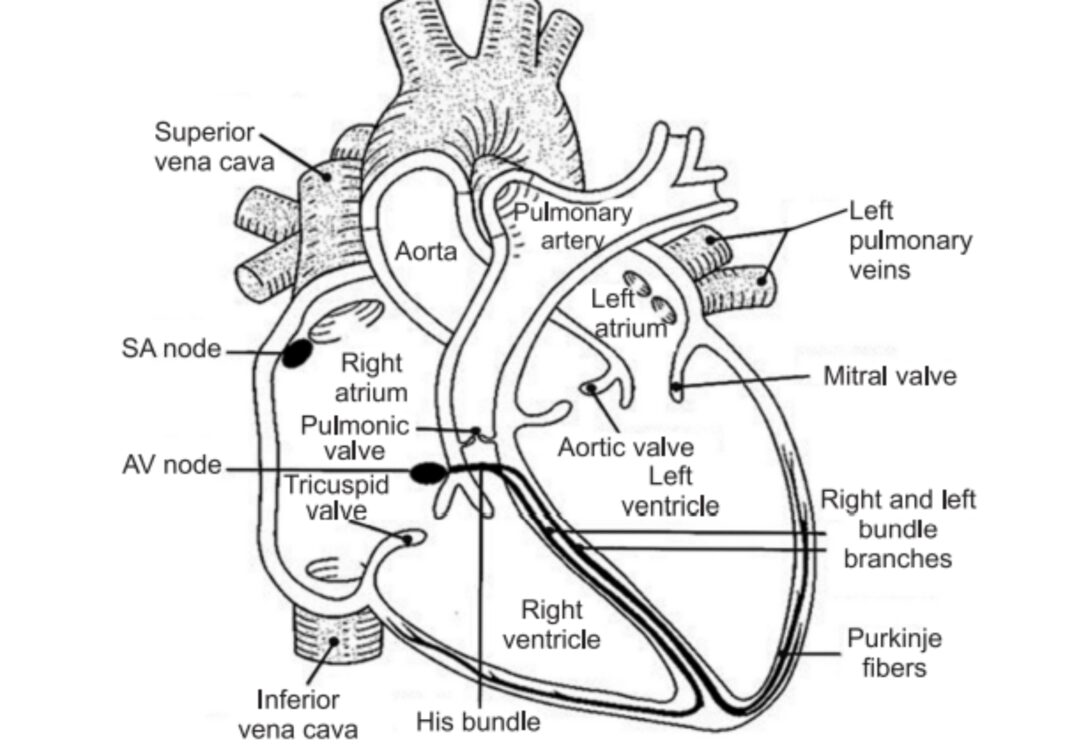Anatomy and Physiology of the Heart | Cardiovascular System Diagram
The heart is muscular organ about the size of a closed fist located in the chest between
the lungs behind the sternum and above the diaphragm. In The Anatomy of the Heart ,It is surrounded by the pericardium. On its superior end, the base of the heart is attached to the aorta, pulmonary arteries and veins, and the vena cava. The inferior tip of the heart, known as the apex, rests just superior to the diaphragm. The base of the heart is located along the body’s midline with the apex pointing toward the left side. Because the heart points to the left, about 2/3 of the heart’s mass is found on the left side of the body and the other 1/3 is on the right. Heart is the pump which is responsible for maintaining adequate circulation of oxygenated blood around the vascular network of the body. It takes in deoxygenated blood through the veins and delivers it to the lungs for oxygenation before pumping it into the various arteries
Anatomy Of Heart🫀 FAQ
Anatomy of the Heart | Correctly Label the following External and Internal Anatomy of the Human Heart
Pericardium: The heart is placed within a fluid filled cavity called as pericardial
cavity. The walls and lining of the pericardial cavity are made up of a special membrane
known as the pericardium. Pericardium is a type of serous membrane that produces
serous fluid to lubricate the heart and prevent friction between the ever beating
heart and its surrounding organs. Besides lubrication, the pericardium serves to hold
the heart in position and maintain a hollow space for the heart to expand when it is full.
The pericardium has two layers, a visceral layer that covers the outside of the heart
and a parietal layer that forms a sac around the outside of the pericardial cavity.
The heart wall is made of three layers: epicardium, myocardium and endocardium.
Epicardium: The epicardium is the outermost layer of the heart wall. It is also
referred to as visceral pericardium, which is inner layer of pericardium. The epicardium is a thin layer of serous membrane that helps to lubricate and protect the outside of the
heart.
Myocardium: Myocardium is the thick middle layer of heart wall and consists of
numerous layers of cardiac muscle fibers that wrap around the heart. Contraction of
myocardium pumps blood out of the heart into the aorta and pulmonary trunk arteries.
Endocardium: Endocardium is the simple squamous endothelium layer that
lines inside the heart. The endocardium is very smooth and is responsible for keeping
blood from sticking to the inside of the heart and forming potentially deadly blood clots. The thickness of the heart wall varies in different parts of the heart. The atria of the
heart have a very thin myocardium because they do not need to pump blood very far, but only to the nearby ventricles. The ventricles, on other hand, have a very thick
myocardium to pump blood to the lungs or throughout the entire body. The right side
of the heart has less myocardium in its walls than the left side because the left side has to pump blood through the entire body while the right side only has to pump to the lungs.
Heart Chambers: The heart contains four chambers: the right atrium, left atrium, right
ventricle and left ventricle. The atria are smaller than the ventricles and have thinner, less muscular walls than the ventricles. The atria act as receiving chambers for blood, so they are connected to the veins that carry blood to the heart. The ventricles are the larger, stronger pumping chambers that send blood out of the heart. The ventricles are connected to the arteries that carry blood away from the heart.
Heart Valves: The heart functions by pumping blood both to the lungs and to the systems of the body. To prevent blood from flowing backwards or “regurgitating” back into the heart, a system of one way valves are present in the heart. The heart valves can be divided into two types: atrioventricular and semilunar valves.
Atrioventricular Valves (AV): The AV valves are located in the middle of the heart
between the atria and ventricles and only allow blood to flow from the atria into the ventricles. The AV valve on the right side of the heart is called the tricuspid valve because it is made of three cusps (flaps) that separate to allow blood to pass through and flow backward. The AV valve on the left side of the heart is called the mitral valve or the bicuspid valve because it has two cusps. The AV valves are attached on the ventricular side to tough strings called chordae tendineae. The chordae tendineae pull on
the AV valves to keep them from folding backwards and allowing blood to flow backward.
Semilunar Valves: The semilunar valves, so named for the crescent moon shape of
their cusps, are located between the ventricles and the arteries that carry blood away from the heart. The semilunar valve on the right side of the heart is the pulmonary valve, so named because it prevents the backflow of blood from the pulmonary trunk
into the right ventricle. The semilunar valve on the left side of the heart is the aortic valve, named for the fact that it prevents the aorta from flowing blood back into the
left ventricle. The semilunar valves are smaller than the AV valves and do not have chordae tendineae to hold them in place. Instead, the cusps of the semilunar valves
are cup shaped to catch the backward flowing blood and use the blood pressure to snap shut.
Heart valves and chambers with their function(table)
| Left and right atria | Chambers that receive blood returning from body through veins. |
| Left and right ventricles | Chambers where blood is pumped to body through arteries |
| Mitral valve | The mitral valve controls the flow of oxygen-rich blood from the left atrium to the left ventricle. |
| Tricuspid valve | The tricuspid valve controls the flow of oxygen-poor blood from the right atrium to the right ventricle. |
| Aortic valve | The aortic valve controls flow of oxygen-rich blood from the left ventricle to the body. |
| Pulmonary valve | The pulmonary valve controls flow of oxygen-poor blood from the right ventricle to the lungs. |
Read Related: Atherosclerosis | Causes |Pathophysiology |Symptoms| Pronunciation
Atherosclerosis | Causes |Pathophysiology |Symptoms| Pronunciation
Wound Healing | Stages And Phases Of Wound Healing PPT
Inflammation Definition | Types Of Inflammation | Etiology | Cardinal Signs

